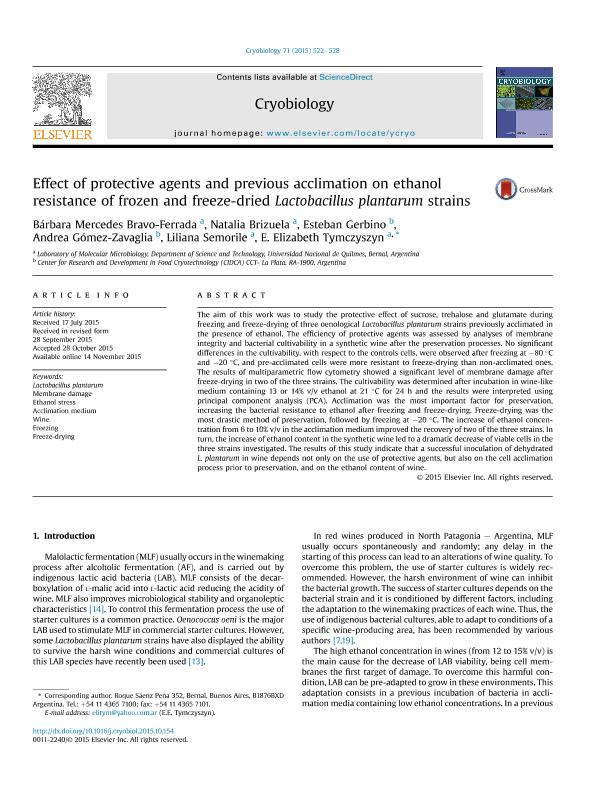Mostrar el registro sencillo del ítem
dc.contributor.author
Bravo Ferrada, Barbara Mercedes

dc.contributor.author
Brizuela, Natalia Soledad

dc.contributor.author
Gerbino, Oscar Esteban

dc.contributor.author
Gomez Zavaglia, Andrea

dc.contributor.author
Semorile, Liliana Carmen

dc.contributor.author
Tymczyszyn, Emma Elizabeth

dc.date.available
2018-04-25T13:25:06Z
dc.date.issued
2015-11
dc.identifier.citation
Bravo Ferrada, Barbara Mercedes; Brizuela, Natalia Soledad; Gerbino, Oscar Esteban; Gomez Zavaglia, Andrea; Semorile, Liliana Carmen; et al.; Effect of protective agents and previous acclimation on ethanol resistance of frozen and freeze-dried Lactobacillus plantarum strains; Academic Press Inc Elsevier Science; Cryobiology; 71; 11-2015; 522-528
dc.identifier.issn
0011-2240
dc.identifier.uri
http://hdl.handle.net/11336/43414
dc.description.abstract
The aim of this work was to study the protective effect of sucrose, trehalose and glutamate during freezing and freeze-drying of three oenological L. plantarum strains previously acclimated in the presence of ethanol. The efficiency of protective agents was assessed by analyses of membrane integrity and bacterial cultivability in a synthetic wine after the preservation processes. No significant differences in the cultivability, with respect to the controls cells, were observed after freezing at -80 ºC and -20 ºC, and pre-acclimated cells were more resistant to freeze-drying than non-acclimated ones. The results of multiparametric flow cytometry showed a significant level of membrane damage after freeze-drying in two of the three strains. The cultivability was determined after incubation in wine-like medium containing 13 or 14% v/v ethanol at 21 °C for 24 h and the results were interpreted using principal component analysis (PCA). Acclimation was the most important factor for preservation, increasing the bacterial resistance to ethanol after freezing and freeze-drying. Freeze-drying was the most drastic method of preservation, followed by freezing at -20 °C. The increase of ethanol concentration from 6 to 10% v/v in the acclimation medium improved the recovery of two of the three strains. In turn, the increase of ethanol content in the synthetic wine led to a dramatic decrease of viable cells in the three strains investigated. The results of this study indicate that a successful inoculation of dehydrated L. plantarum in wine depends not only on the use of protective agents, but also on the cell acclimation process prior to preservation, and on the ethanol content of wine.
dc.format
application/pdf
dc.language.iso
eng
dc.publisher
Academic Press Inc Elsevier Science

dc.rights
info:eu-repo/semantics/openAccess
dc.rights.uri
https://creativecommons.org/licenses/by-nc-sa/2.5/ar/
dc.subject
Lactobacillus Plantarum
dc.subject
Membrane Damage
dc.subject
Ethanol Stress
dc.subject
Acclimation Medium
dc.subject
Wine
dc.subject
Freezingfreeze-Drying
dc.subject.classification
Alimentos y Bebidas

dc.subject.classification
Otras Ingenierías y Tecnologías

dc.subject.classification
INGENIERÍAS Y TECNOLOGÍAS

dc.subject.classification
Alimentos y Bebidas

dc.subject.classification
Otras Ingenierías y Tecnologías

dc.subject.classification
INGENIERÍAS Y TECNOLOGÍAS

dc.title
Effect of protective agents and previous acclimation on ethanol resistance of frozen and freeze-dried Lactobacillus plantarum strains
dc.type
info:eu-repo/semantics/article
dc.type
info:ar-repo/semantics/artículo
dc.type
info:eu-repo/semantics/publishedVersion
dc.date.updated
2018-04-17T20:00:36Z
dc.journal.volume
71
dc.journal.pagination
522-528
dc.journal.pais
Estados Unidos

dc.journal.ciudad
Amsterdam
dc.description.fil
Fil: Bravo Ferrada, Barbara Mercedes. Consejo Nacional de Investigaciones Científicas y Técnicas; Argentina. Universidad Nacional de Quilmes. Departamento de Ciencia y Tecnología. Laboratorio de Microbiología Molecular; Argentina
dc.description.fil
Fil: Brizuela, Natalia Soledad. Consejo Nacional de Investigaciones Científicas y Técnicas; Argentina. Universidad Nacional de Quilmes. Departamento de Ciencia y Tecnología. Laboratorio de Microbiología Molecular; Argentina
dc.description.fil
Fil: Gerbino, Oscar Esteban. Provincia de Buenos Aires. Gobernación. Comisión de Investigaciones Científicas. Centro de Investigación y Desarrollo en Criotecnología de Alimentos. Consejo Nacional de Investigaciones Científicas y Técnicas. Centro Científico Tecnológico Conicet - La Plata. Centro de Investigación y Desarrollo en Criotecnología de Alimentos. Universidad Nacional de La Plata. Facultad de Ciencias Exactas. Centro de Investigación y Desarrollo en Criotecnología de Alimentos; Argentina
dc.description.fil
Fil: Gomez Zavaglia, Andrea. Provincia de Buenos Aires. Gobernación. Comisión de Investigaciones Científicas. Centro de Investigación y Desarrollo en Criotecnología de Alimentos. Consejo Nacional de Investigaciones Científicas y Técnicas. Centro Científico Tecnológico Conicet - La Plata. Centro de Investigación y Desarrollo en Criotecnología de Alimentos. Universidad Nacional de La Plata. Facultad de Ciencias Exactas. Centro de Investigación y Desarrollo en Criotecnología de Alimentos; Argentina
dc.description.fil
Fil: Semorile, Liliana Carmen. Universidad Nacional de Quilmes. Departamento de Ciencia y Tecnología. Laboratorio de Microbiología Molecular; Argentina
dc.description.fil
Fil: Tymczyszyn, Emma Elizabeth. Consejo Nacional de Investigaciones Científicas y Técnicas; Argentina. Universidad Nacional de Quilmes. Departamento de Ciencia y Tecnología. Laboratorio de Microbiología Molecular; Argentina
dc.journal.title
Cryobiology

dc.relation.alternativeid
info:eu-repo/semantics/altIdentifier/doi/http://dx.doi.org/10.1016/j.cryobiol.2015.10.154
dc.relation.alternativeid
info:eu-repo/semantics/altIdentifier/url/https://www.sciencedirect.com/science/article/pii/S0011224015004216
Archivos asociados
